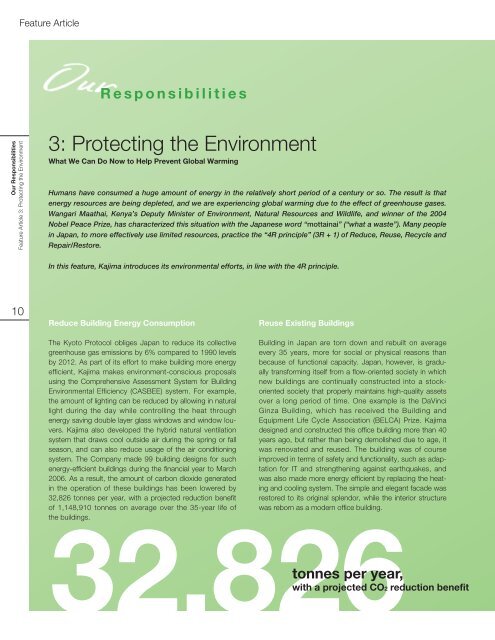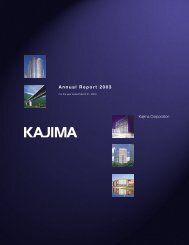full Annual Report 2006 (PDF 3.2MB)
full Annual Report 2006 (PDF 3.2MB)
full Annual Report 2006 (PDF 3.2MB)
Create successful ePaper yourself
Turn your PDF publications into a flip-book with our unique Google optimized e-Paper software.
Feature ArticleResponsibilitiesOur ResponsibilitiesFeature Article 3: Protecting the Environment3: Protecting the EnvironmentWhat We Can Do Now to Help Prevent Global WarmingHumans have consumed a huge amount of energy in the relatively short period of a century or so. The result is thatenergy resources are being depleted, and we are experiencing global warming due to the effect of greenhouse gases.Wangari Maathai, Kenya’s Deputy Minister of Environment, Natural Resources and Wildlife, and winner of the 2004Nobel Peace Prize, has characterized this situation with the Japanese word “mottainai” (“what a waste”). Many peoplein Japan, to more effectively use limited resources, practice the “4R principle” (3R + 1) of Reduce, Reuse, Recycle andRepair/Restore.In this feature, Kajima introduces its environmental efforts, in line with the 4R principle.10Reduce Building Energy ConsumptionReuse Existing BuildingsThe Kyoto Protocol obliges Japan to reduce its collectivegreenhouse gas emissions by 6% compared to 1990 levelsby 2012. As part of its effort to make building more energyefficient, Kajima makes environment-conscious proposalsusing the Comprehensive Assessment System for BuildingEnvironmental Efficiency (CASBEE) system. For example,the amount of lighting can be reduced by allowing in naturallight during the day while controlling the heat throughenergy saving double layer glass windows and window louvers.Kajima also developed the hybrid natural ventilationsystem that draws cool outside air during the spring or fallseason, and can also reduce usage of the air conditioningsystem. The Company made 99 building designs for suchenergy-efficient buildings during the financial year to March<strong>2006</strong>. As a result, the amount of carbon dioxide generatedin the operation of these buildings has been lowered by32,826 tonnes per year, with a projected reduction benefitof 1,148,910 tonnes on average over the 35-year life ofthe buildings.32,826Building in Japan are torn down and rebuilt on averageevery 35 years, more for social or physical reasons thanbecause of functional capacity. Japan, however, is graduallytransforming itself from a flow-oriented society in whichnew buildings are continually constructed into a stockorientedsociety that properly maintains high-quality assetsover a long period of time. One example is the DaVinciGinza Building, which has received the Building andEquipment Life Cycle Association (BELCA) Prize. Kajimadesigned and constructed this office building more than 40years ago, but rather than being demolished due to age, itwas renovated and reused. The building was of courseimproved in terms of safety and functionality, such as adaptationfor IT and strengthening against earthquakes, andwas also made more energy efficient by replacing the heatingand cooling system. The simple and elegant facade wasrestored to its original splendor, while the interior structurewas reborn as a modern office building.tonnes per year,with a projected CO2 reduction benefit






